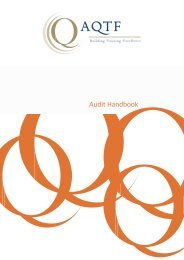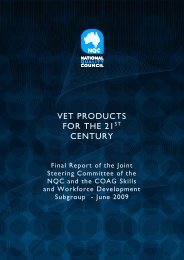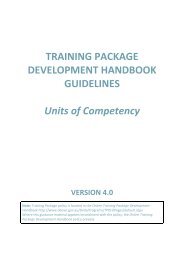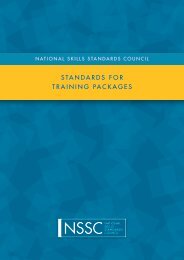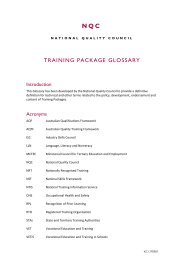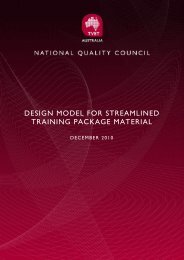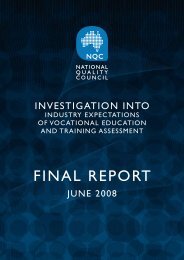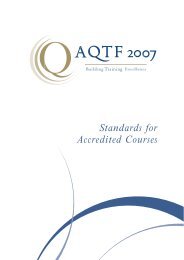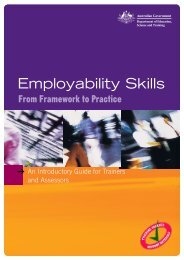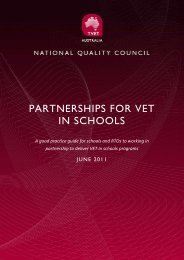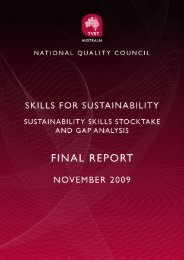Guide for Developing Assessment Tools - National Skills Standards ...
Guide for Developing Assessment Tools - National Skills Standards ...
Guide for Developing Assessment Tools - National Skills Standards ...
- No tags were found...
Create successful ePaper yourself
Turn your PDF publications into a flip-book with our unique Google optimized e-Paper software.
NQC | <strong>Guide</strong> <strong>for</strong> developing assessment toolsthe tool and/or the severity of judgements.ModeratorPanelling of assessment toolsParallel <strong>for</strong>ms of reliabilityPiloting of assessment toolsPredictive validityPrinciples of assessmentQuality assuranceQuality controlQuality reviewReasonable adjustmentsReliabilityRisk <strong>Assessment</strong>Risk IndicatorsRubricsRules of evidenceIn this <strong>Guide</strong> moderator means a person responsible <strong>for</strong> carrying out moderationprocesses. A moderator may be external or internal to the organisation.A quality assurance process <strong>for</strong> checking the relevance and clarity of the tool prior to usewith other colleagues (i.e. who have expertise within the Units of Competency and/orassessment tool development). This may involve examining whether the content of thetool is correct and relevant to industry, the unit(s) f; the instructions are clear <strong>for</strong>candidates and assessors and that there is not potential bias within the design of the tool.A type of reliability which is concerned with determining the equivalence of two alternative<strong>for</strong>ms of a task.A quality assurance process <strong>for</strong> checking the appropriateness of the tool withrepresentatives from the target group This may involve administering the tool with a smallnumber of individuals (who are representative of the target group) and gathering feedbackon both their per<strong>for</strong>mance and perceptions of the task. Piloting can help determine theappropriateness of the amount of time to complete the task, the clarity of the instructions,the task demands (i.e. whether it is too difficult or easy to per<strong>for</strong>m) and its perceivedrelevance to the workplace.A <strong>for</strong>m of criterion validity concerned with the ability of the assessment outcomes toaccurately predict the future per<strong>for</strong>mance of the candidate.To ensure quality outcomes, assessments should be:• Fair• Flexible• Valid• Reliable• Sufficient.Concerned with establishing appropriate circumstances <strong>for</strong> assessment to take place. It isan input approach to assessment quality management.Concerned with monitoring, and where necessary, making adjustments to decisionsmade by assessors prior to the finalisation of assessment results/outcomes. It is referredto as an active approach to assessment quality management.Concerned with the review of the assessment tools, procedure and outcomes to makeimprovements <strong>for</strong> future use. It is referred to as a retrospective approach to assessmentquality management.Adjustments that can be made to the way in which evidence of candidate per<strong>for</strong>mancecan be collected. Whilst reasonable adjustments can be made in terms of the way inwhich evidence of per<strong>for</strong>mance is gathered, the evidence criteria <strong>for</strong> makingcompetent/not yet competent decisions [and/or awarding grades] should not be altered inany way. That is, the standards expected should be the same irrespective of the groupand/or individual being assessed, otherwise comparability of standards will becompromised.One of the principles of assessment. There are five types of reliability: internalconsistency, parallel <strong>for</strong>ms, split-half, inter-rater and intra rater. In general, reliability is anestimate of how accurate or precise the task is as a measurement instrument. Reliabilityis concerned with how much error is included in the evidence.Concerned with gauging the likelihood of unexpected and/or un<strong>for</strong>tunateconsequences. For example, determining the level of risk (e.g. in terms of safety,costs, equity etc) of assessing someone as competent when in actual fact they arenot yet competent, and or vice versa.The potential factors that may increase the risk associated with the assessment.These factors should be considered when selecting a representative sample <strong>for</strong>validation and/or moderation. Risk factors may include safety (eg potential dangerto clients from an incorrect judgement), equity (eg. outcomes impacting on highlycompetitive selection procedures), human capacity (eg experience and expertiseof assessors) etc.They are <strong>for</strong>mally defined as scoring guides, consisting of specific pre-establishedper<strong>for</strong>mance indicators, used in judging the quality of candidate work onper<strong>for</strong>mance assessments. They tend to be designed using behaviourally anchoredrating scales in which each point on the rating scale is accompanied by adescription of increasing levels of proficiency along a developmental continuum ofcompetence.These are closely related to the principles of assessment and provide guidance onthe collection of evidence to ensure that it is valid, sufficient, authentic and current.GUIDE FOR DEVELOPING ASSESSMENT TOOLS PAGE 26



